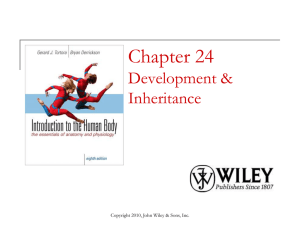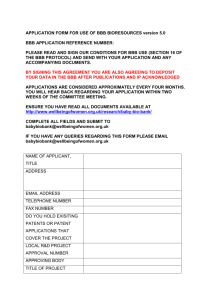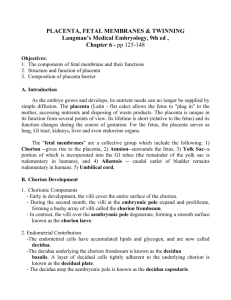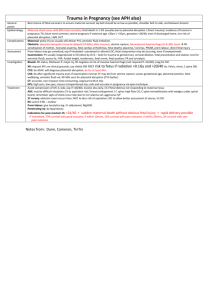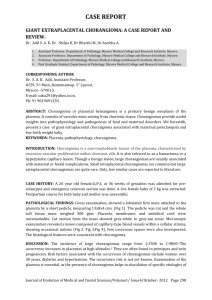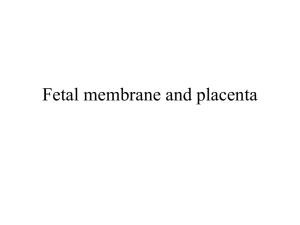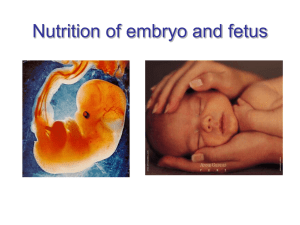The Placenta
advertisement
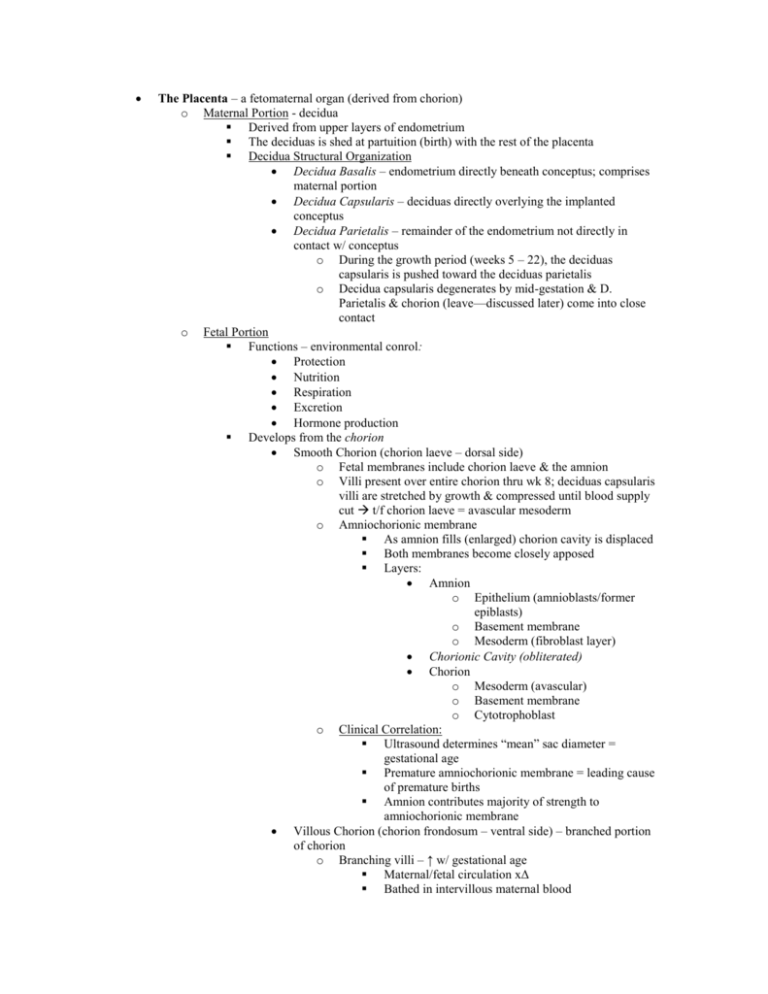
The Placenta – a fetomaternal organ (derived from chorion) o Maternal Portion - decidua Derived from upper layers of endometrium The deciduas is shed at partuition (birth) with the rest of the placenta Decidua Structural Organization Decidua Basalis – endometrium directly beneath conceptus; comprises maternal portion Decidua Capsularis – deciduas directly overlying the implanted conceptus Decidua Parietalis – remainder of the endometrium not directly in contact w/ conceptus o During the growth period (weeks 5 – 22), the deciduas capsularis is pushed toward the deciduas parietalis o Decidua capsularis degenerates by mid-gestation & D. Parietalis & chorion (leave—discussed later) come into close contact o Fetal Portion Functions – environmental conrol: Protection Nutrition Respiration Excretion Hormone production Develops from the chorion Smooth Chorion (chorion laeve – dorsal side) o Fetal membranes include chorion laeve & the amnion o Villi present over entire chorion thru wk 8; deciduas capsularis villi are stretched by growth & compressed until blood supply cut t/f chorion laeve = avascular mesoderm o Amniochorionic membrane As amnion fills (enlarged) chorion cavity is displaced Both membranes become closely apposed Layers: Amnion o Epithelium (amnioblasts/former epiblasts) o Basement membrane o Mesoderm (fibroblast layer) Chorionic Cavity (obliterated) Chorion o Mesoderm (avascular) o Basement membrane o Cytotrophoblast o Clinical Correlation: Ultrasound determines “mean” sac diameter = gestational age Premature amniochorionic membrane = leading cause of premature births Amnion contributes majority of strength to amniochorionic membrane Villous Chorion (chorion frondosum – ventral side) – branched portion of chorion o Branching villi – ↑ w/ gestational age Maternal/fetal circulation xΔ Bathed in intervillous maternal blood o Chorionic Plate – “roof” of the placenta (fetal side) Chorion layers (continuous w/chorionic villi): Extraembryonic mesoderm (core of villi) Cytotophoblast (surrounds core of villi) Syncytiotophoblast (outer layer of villi) Main stem villi emerge from underside of chorionic plate like “processes” of plate extending out Umbilical blood vessels branch out across chorionic plate to main stem villi & into branching villi for nutrient exchange (intervillous space); vascularized mesoderm continuous w/ umbilical cord Amnion tightly opposes mesoderm (extraembryonic) o Chorionic Villi ↑ placental xΔ w/ gestational age ↑ villus branching (increased surface area) Thinner placental barrier (less separation) Early gestation–fetal capillaries deep in mesenchyme 3rd Trimester – capillaries at villi periphery (initially located centrally in capillaries); reduced trophoblast persist Syncytiotrophoblast–mediates xΔ (outer villus) o Apical brush border o Continually undergo apoptosis (form synctial knots); shed into maternal blood via intervillous space o Renewal by underlying cytotrophoblast (trophoblast stem cells) fusing w/syncytium (syncytiotrophoblast conglomerate) Basal Plate – “floor” of the placenta (maternal side) Anchoring Villi – chorionic villi contact deciduas due to trophoblast proliferation Trophoblast become extravillous by breaking through syncytiotrophoblastic “contact” point & colonizing deciduas Trophoblast in deciduas is known as cytokeratin 7 positive, derived from epithelium (Ab used for staining) Trophoblast invade maternal arteries (upper 1/3 myometrium ) Remodeled – dialated for ↑ blood volume Clinical correlation: Preeclampsia: pregnancy-induced high blood pressure o Remodel failure – reduced blood flow (preeclampsia) o Maternal compensation - ↑ BP o May result in intrauterine growth retardation o Treatment: birth+placental delivery o Amniotic Fluid o Formed from water in maternal & fetal circulation (~ 1000 cc at term) Diffuses from decidua parietalis across amniochorionic membrane Later from intervillous blood across chorionic plate XΔ of fluid w/ fetal lungs, intestine & kidneys (fetal swallowing & excretion) Protection: Buoyant medium for symmetric growth Prevents adhesion of amnionitic membrane to embryo Cushions against maternal impacts Controls fetal body temperature Permits fetal mvmt (musculoskeletal development) Provides protection against infection o Clinical Correlation: Oligohydramnios – reduced amniotic fluid (< 400 cc) Associated w/low blood flow Causes o Often preterm rupture (partial) of amniochorionic membrane o Kidneys do not form o Urinary tract obstructed (no urine produced/excreted) Polyhydramnios – increased amniotic fluid (up to 2000 cc) Poor fetal swallowing of amniotic fluid caused by o CNS disorders or o Mechanical blockage of digestive tract (e.g. esophageal atresia) Umbilical Cord o During expansion & folding of amnion, connecting stalk becomes ensheathed w/ amnion o Composed of: An outermost layer of amnion A mucoid mesoderm (connecting stalk) known as Wharton’s Jelly 2 umilical fetal arteries (deoxygenated blood - fetal heart placenta); 1 umbilical vein (oxygenated blood - placenta fetal heart) Vitelline duct (segment of YS closest to fetus) YS stalk 2 blood vessels o Fetal Death or Injury Knot formation – blocks fetal blood flow Cord entanglement – can destroy fetal tissue (e.g. limbs) Placental Circulation o Intervillous Space – b/w chorionic plate & basal plate = gas exchange Spiral uterine arteries bring O2-rich blood; empty thru placental floor /basal plate Maternal/Fetal Exchange: as maternal blood moves toward the roof (chorionic plate) & returns toward the floor (basal plate), chorionic villi bathed in blood Uterine veins drain deoxygenated blood o Fetal Circulation (arteries away from heart; veins toward heart) Deoxygenated blood from fetus heart to placenta through 2 umbilical arteries Oxygenated blood returns from placenta through venules in the villi to veins connecting to the single umbilical vein to the fetal heart Placental Transport o Mechanisms used for transport across the placental barrier Simple Diffusion – water, gases Facilitated Diffusion – electrolytes, Cl- (charge-mediated) Active Transport – sodium (ATP dependent) Pinocytosis – proteins (bulk transfer, endocytosis) Breaks in placental membrane barrier; cells cross o Gases: O2 & CO2 move through partial pressure gradients (high to low) Maternal pO2 = 50 mm Hg Villus fetal blood pO2 = 30 mm Hg Placental membrane pO2 = 20 mm Hg Fetal blood pO2 = low (compensated by 25% more fetal Hb carrying capacity) o o Nutrients – most cross freely Waste products – cross freely (CO2, urea, uric acid, bilirubin, creatinine) Antibodies – IgG crosses freely (confers passive immunity to fetus); no other Ig’s cross freely; IgA, an antibody that does not cross the placental barrier but is absorbed through the digestive tract, is the antibody found in breast milk. o Drugs – most by simple diffusion Endocrine Functions of the Placenta – hormones secreted by syncytiotrophoblast o Human Chorionic Gonadotropin (HcGH) - maintains Corpus Luteum (CL) which secretes progesterone (maintains endometrium until placenta takes over – week 10) o Human Placental Lactogen – breast development, fetal protein deposition, ↓ maternal glucose utilization o Progesterone – development/maintenance of dedidua cells, prevents uterine contractions; sufficient amount to take over for CL by week 10 o Estrogen – enlargement of uterus, breasts, breast glands, & ext. genitalia (for delivery) o o o Delivery & Afterbirth o Amnion rupture – “water breaks” o Labor – uterine smooth muscle contractions that expel fetus & after birth Stage 1: contraction Stage 2: fetal delivery Stage 3: placental delivery o Afterbirth – Placenta – flattened disc shape Fetal side: o umbilical cord attached (usually central) o amnion & chorion laeve present; can be separated w/forceps o amnion also tight against placenta at chorionic plate o Lg chorionic plate blood vessels are visible under surface Maternal side: o Cotyledons – cobblestone appearance on surface o Pieces of decidua – appear as a thin, skin-like covering over the cotyledons Umbilical Cord: 1 – 2 cm diameter; 30 – 90 cm length Placenta & Membranes of Twins o Dizogotic – hereditary basis Two separate embryos due to ovulation of two oocytes Two implantation sites, each forming separate placenta, amnion & chorion; placenta &/or chorions may fuse, however Placentas & chorions may fuse—histilogical study would show one chorion (two fused) surrounded by amnions (one from each fetus) If same gender, DNA testing required to determine if dizygotic or monozygotic o Monozygotic – no hereditary basis Separation of embryonic material w/i single embryo arising from single oocyte; twins are genetically identical (note: t/f will have same gender) Split prior to blastocyst stage (cavitation & formation of ICM): 35% Two separate blastocysts, t/f same as dizygotic twins (i.e. two placentas, two amnions, two chorions Placentas & chorions may fuse—histilogical study would show one chorion (two fused) surrounded by amnions (one from each fetus) DNA testing necessary to determine if dizygotic or monozygotic Split during blastocyst stage: 65% One blastocyst (t/f one chorion & one placenta) Two separate ICM’s (t/f two amniotic sacs) Split after implantation: 1% After blastocyst stage: t/f one chorion & one placenta Division of embryonic disc (after bilaminar formation) w/in amnion: t/f one amnion Clinical Correlation: o Intertwined umbilical cords o Conjoined twins – incomplete separation blastocysts/ICM o Parasitic twins – Parasitic twins are a variation on conjoined twins—except one of the twins stopped developing during gestation and is now vestigial to a healthy, otherwise mostly fully-formed individual twin. The undeveloped twin is defined as parasitic, rather than conjoined, because it is incompletely formed or wholly dependent on the body functions of the complete fetus (definition from Wikipedia online)

